Newly-promoted Brest have been doing okay in Ligue 1 this season. They are currently sitting 14th in the Ligue 1 table with 28 points, but they’re not far from getting to the upper-side of mid-table as only three points currently separate them from seventh-placed Lille. A win (and favourable results from other teams) can see them shoot up the table, a little closer to the European spot and a little further from the relegation zone.
Brest are rather effective and efficient in attack. They are currently the eighth-highest-scoring team in Ligue 1 with 28 goals, but they’ve conceded a decent amount as well. They have conceded 27 goals so far in the league. What you need to know though is that they could have conceded many, many more goals were it not for their main goalkeeper Gautier Larsonneur.
Brest’s xGA (expected goals allowed) of a massive 47 shows that they’ve been letting their opponents get high-quality chances to easily, but how did they still manage to concede so little? The answer lies on the man between the sticks and in this tactical analysis/scout report, we’ll look into how he fits into Brest’s tactics and see how good he actually is.
Pros and Cons of his physique
Larsonneur is 1.81m tall and weighs 70kg which is actually rather small for a goalkeeper although this is not exactly bizarre as there are already many top goalkeepers that have played in the past or currently still active that don’t necessarily have big size such as René Higuita, Iker Casillas, Guillermo Ochoa, Kostas Lamprou, and David Ospina just to name a few.
The 1997-born French goalkeeper has a lean body build with rather small upper and lower muscle size. His small frame, however, gives him certain benefits to his goalkeeping attribute.
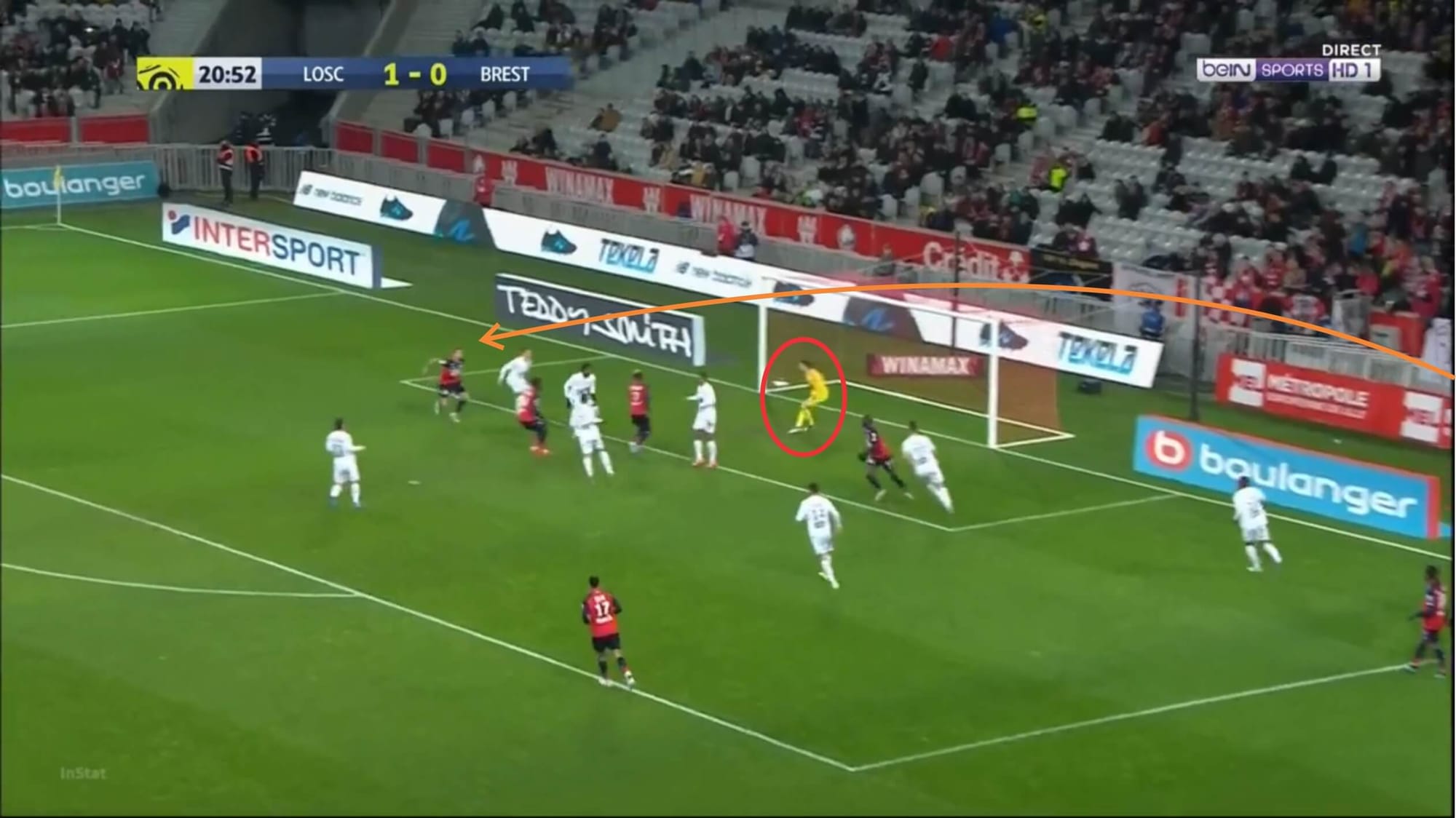
Larsonneur is very agile and well-coordinated. This can be seen from the way he’s always able to quickly rotate his hips and adjust his body position to make sure his positioning is always square with the ball. His ability to recover really quickly after a dive is also outstanding and again, proves how agile he is and how good he is in controlling his body. His good coordination can also be seen from the way he moves around the penalty box as he covers his area and his neat footwork that accompanies his movement.
Despite not being very tall, Larsonneur is lightweight and this helps him a lot when diving. The combination of his excellent agility and coordination with the addition of quick reflexes and reaction time, explosive lunges, and technique also massively improves his ability to make diving saves.
Larsonneur also possesses good short-range speed which is quite important as he’d often rush off his line to intercept and collect the ball or even clear the ball in certain situations. Below you can see his impressive burst of acceleration as he intercepts a through ball from the opposition.
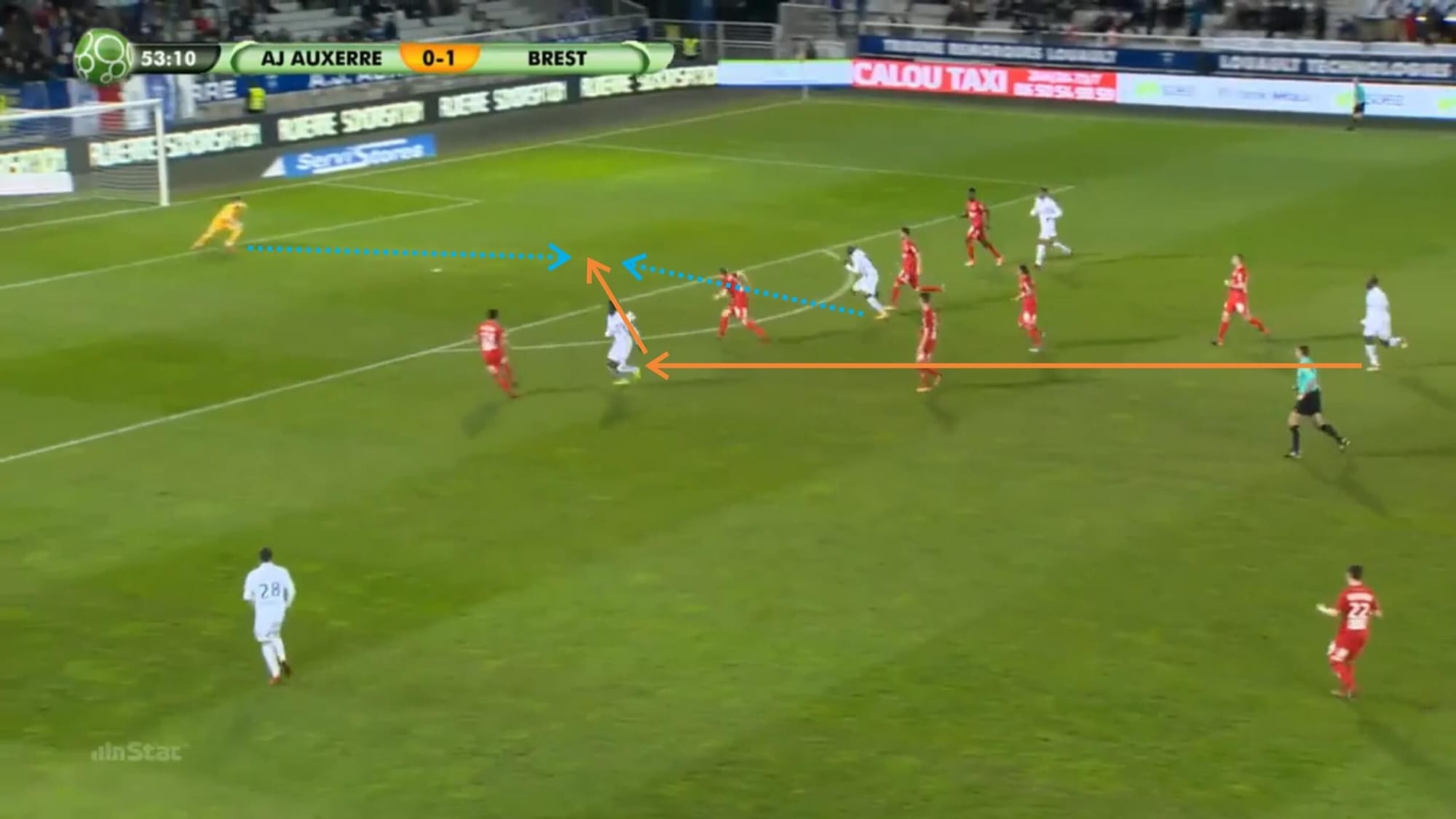
Above you can see that Larsonneur was already on his toes and has already anticipated the through ball. He timed his burst well and quickly accelerated and intercepted the ball before the opposing striker got to the ball.
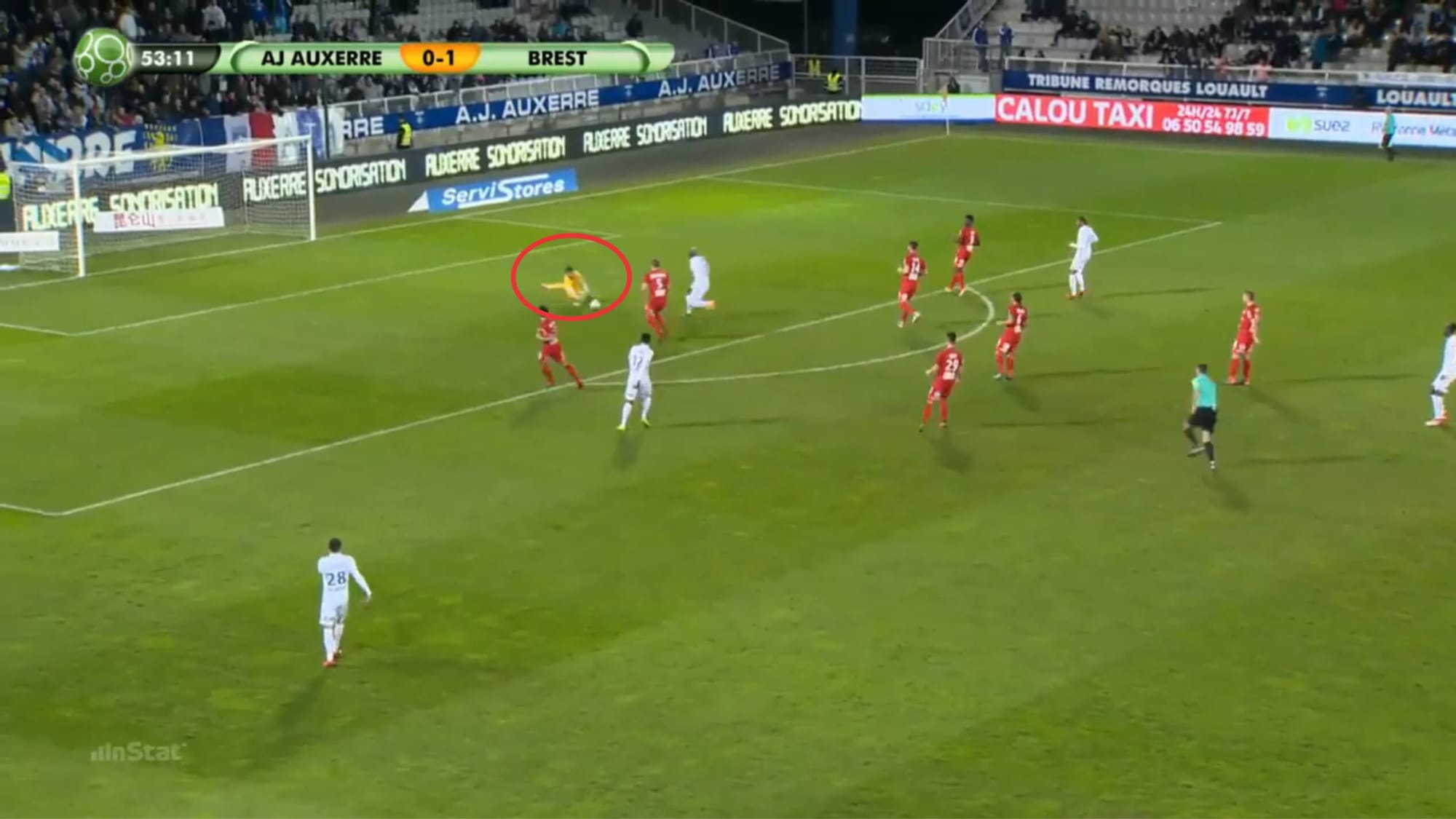
Attributes like anticipation, reaction, concentration, and timing, of course, played a big part in this particular situation. However, his speed, his explosiveness lifts his game up a notch.
As explained in this tactical analysis/scout report, Larsonneur’s best physical attributes are his agility, coordination, and quickness. This is not something that big, muscular goalkeepers would usually possess. However, his weaknesses, quite apparently, lie in his size, strength, and power.
Larsonneur’s small frame affects his aerial reach, and this is something that a lot of his opponents would take advantage of – which is by curling the ball into the far corner. However, though his inability to stretch very far is something that the opposition would often try exploit, he’s usually still able to mask his weakness due to his excellent diving ability as well as good body orientation and positioning to cover the goal (which will be explained more in the next section).
However, his lack of aerial reach, strength, and power do bring disadvantages when it comes to aerial challenges.
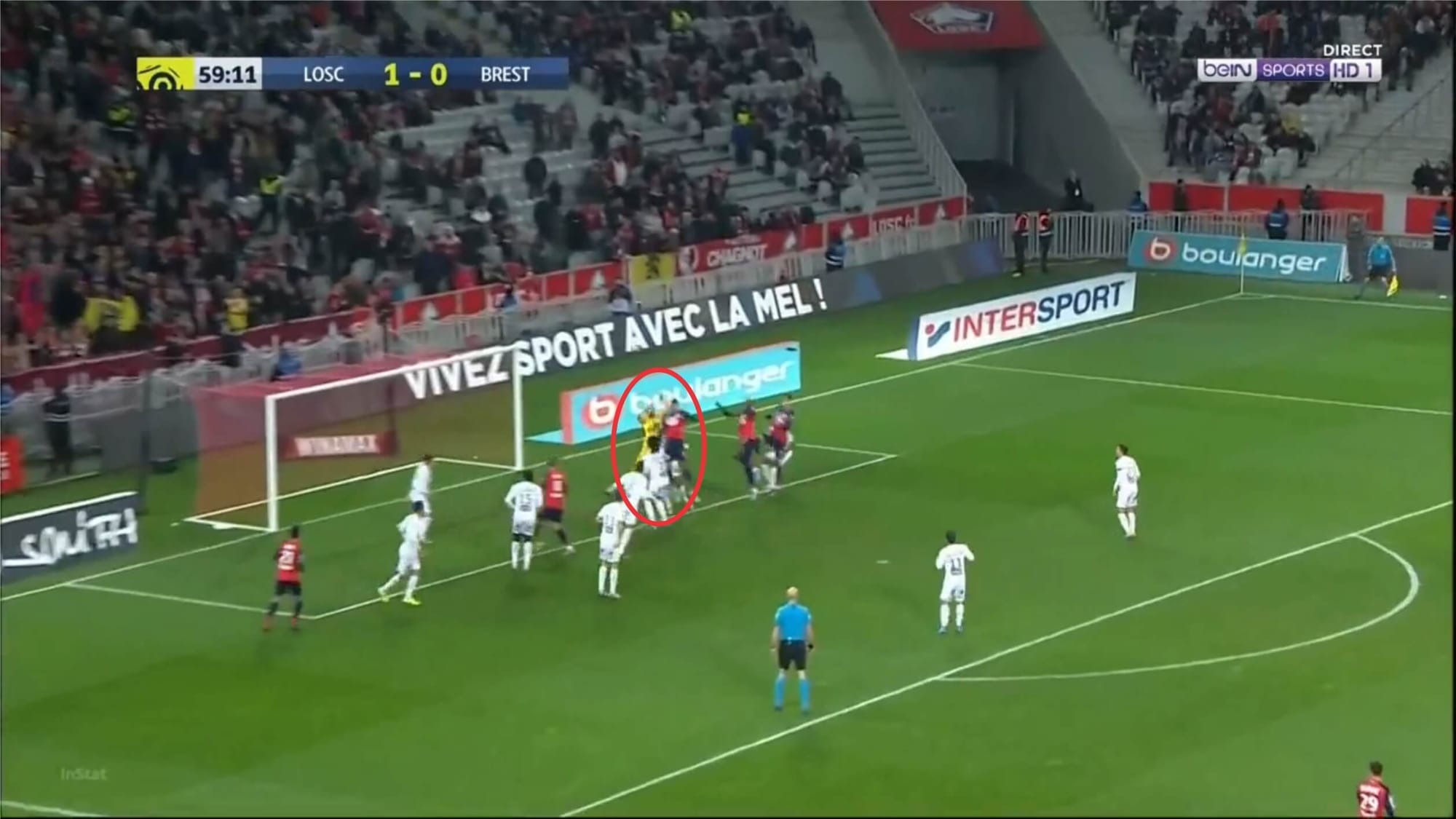
Above you can see Larsonneur struggling to beat Gabriel for the ball in an aerial challenge due to his lack of size and strength. Although, in this situation, Larsonneur still managed to get his hands to punch the ball away (very weakly), it is very much apparent that he’s uncomfortable in situations like this. Aerial challenges, especially inside the six-yard box against bigger and stronger opponents can be quite risky for him, although Larsonneur usually doesn’t have much problem against opponents with smaller or similar stature.
Combination of tactical intelligence and good technique
What makes Larsonneur an outstanding goalkeeper is his intelligence and technique both in goalkeeping or with the ball.
As mentioned before in this tactical analysis/scout report, Larsonneur has limited reach which makes him quite vulnerable to shots into the far corner of the net. However, his smart body orientation and positioning to cover the goal are the two attributes he relies a lot on to mask his weakness.
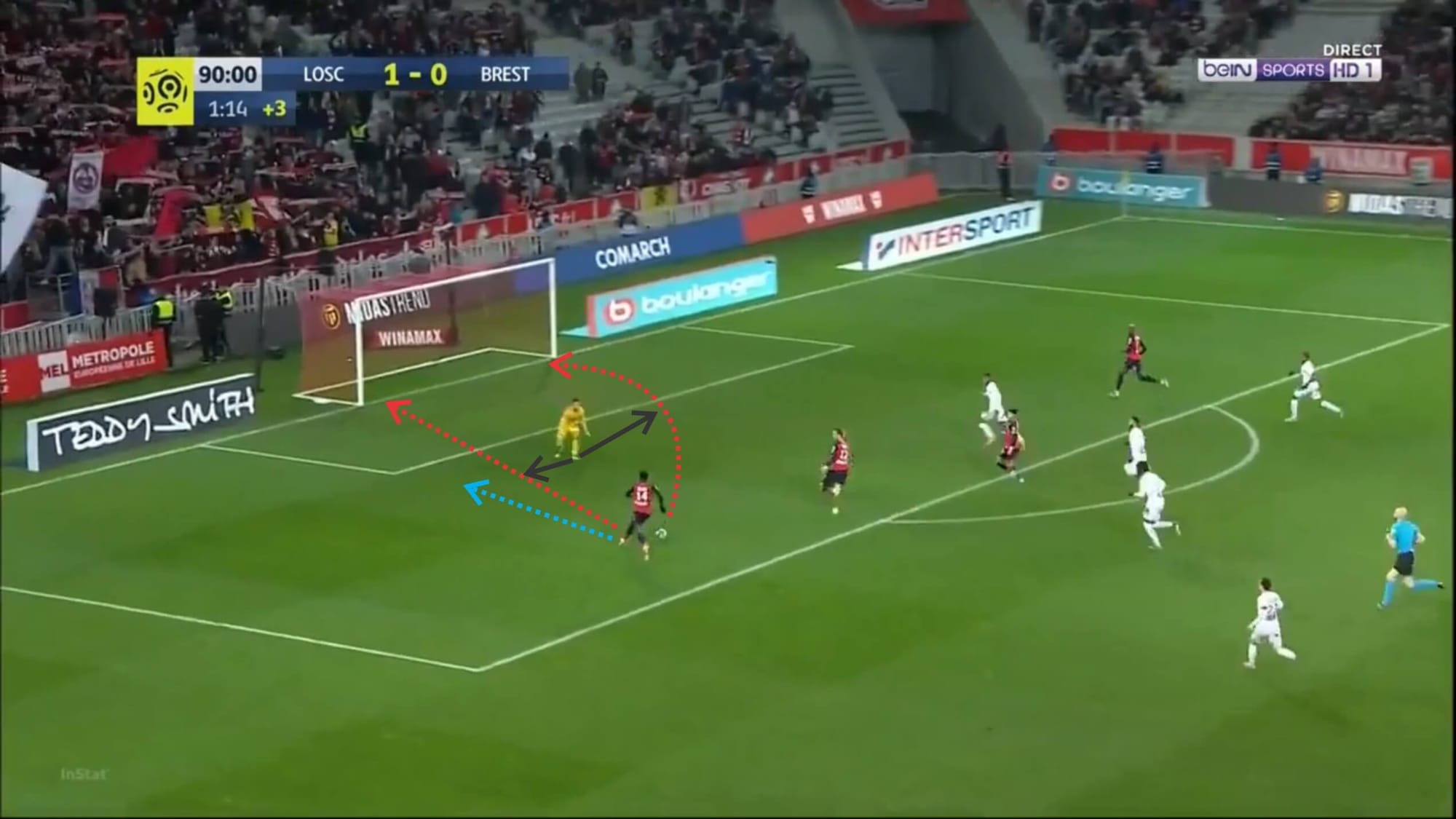
In the picture above you can see Larsonneur’s positioning, particularly in a 1v1 situation. In this situation, you can see Larsonneur’s body orientation, he’s square with the ball and he’s on his toes instead of stuck to the ground which would allow him to move more flexibly and have greater reach or range of leap.
As he’s aware of his lack of size, he came a bit further off his line to cover Jonathan Bamba’s shooting angle much better, however, he still kept a distance in anticipation of a lobbed shot or if Bamba decided to do a dummy and try to get around the goalkeeper before taking a shot. Despite his body language making it look like he’d shoot the ball to the far corner, Bamba then decided to try to get around Larsonneur. However, the French goalkeeper already anticipated the move and stole the ball from Bamba’s feet before the latter managed to get past him.
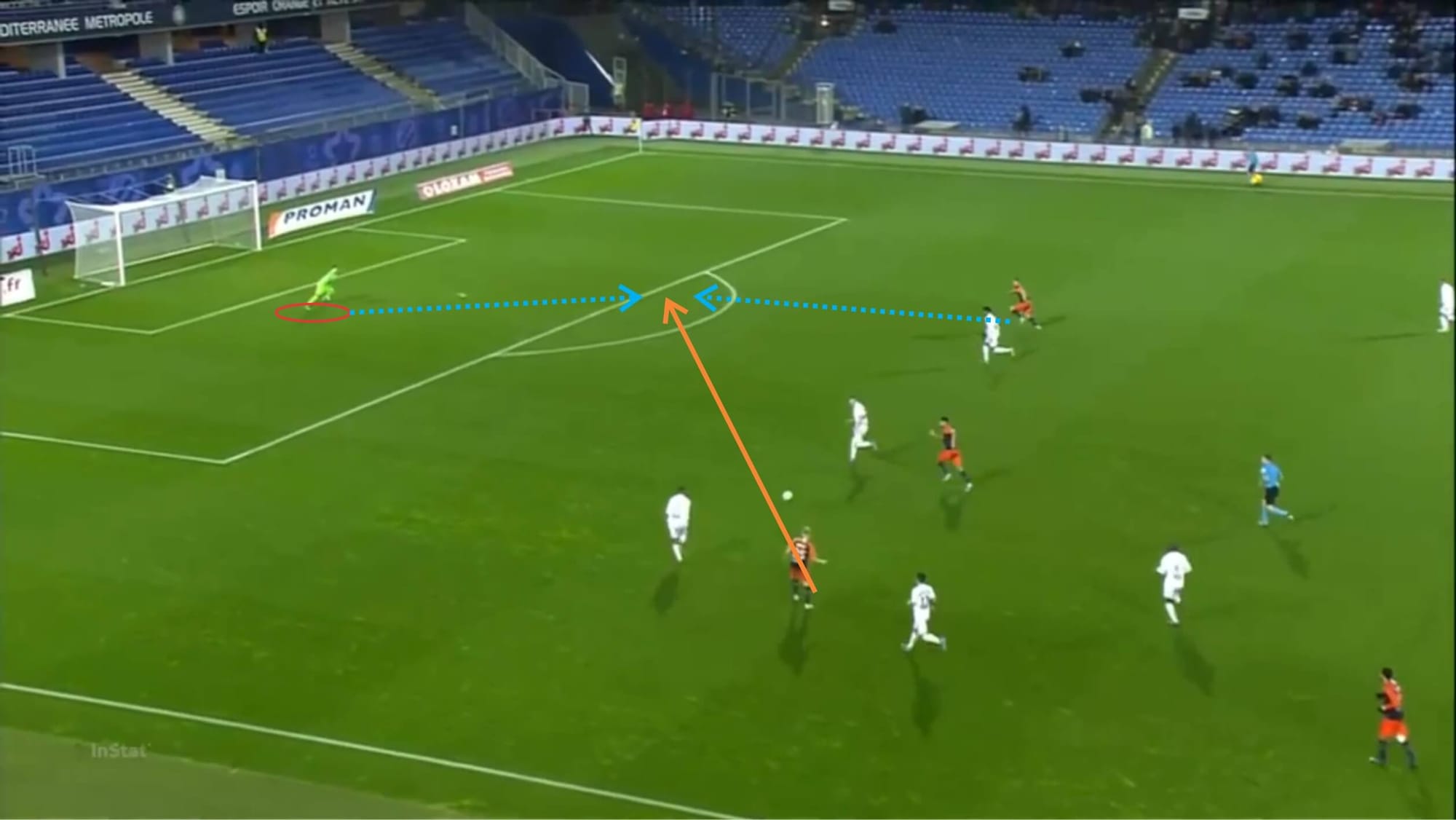
Here we can see a bit clearer how Larsonneur positions himself in anticipation for a through pass into space. In this situation, he saw that a Montpellier attacker was making a run and could potentially break free with a through pass and therefore positioned himself a bit high off his line. The through pass was then played and using his speed and quick reactions, Larsonneur managed to intercept the ball. However, in this situation, his teammate failed to clear the ball and the opposing team managed to score a goal as Larsonneur wasn’t able to get back to his position in time.
Stats-wise, Larsonneur averages 43 interceptions (both ground interceptions and aerial interceptions) which is the third-highest amount of interceptions in Ligue 1 but only has a success rate of 86% which is the fourth-lowest success rate. This is partly due to his weakness in aerial interceptions and also some other times, overconfidence in rushing out to make ground interceptions.
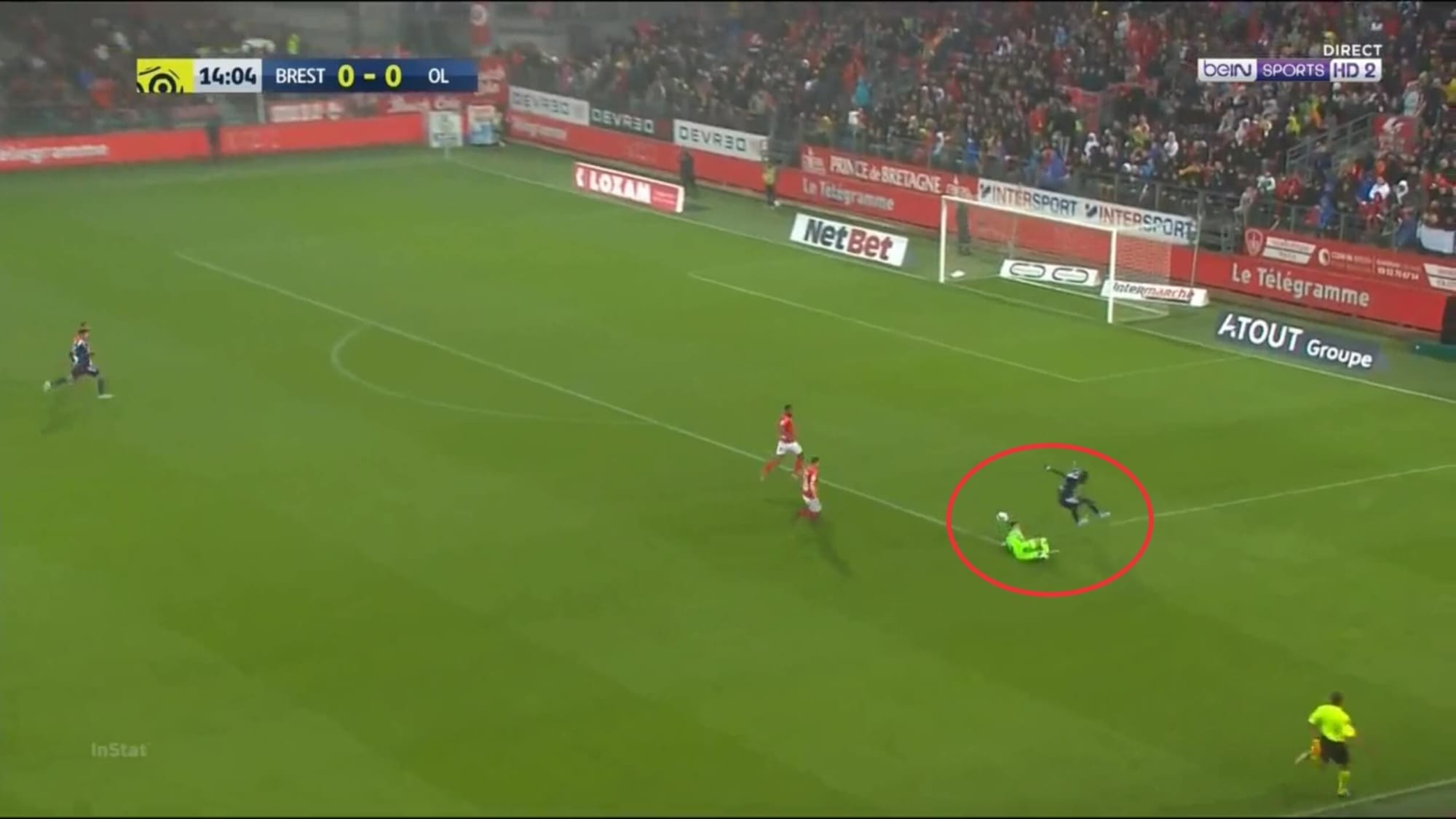
The 1997-born goalkeeper is very brave as he’s never afraid to get stuck in and engage bigger players in both ground and aerial duels. He also shows bravery and confidence as he’d very often rush off his line and clear the ball away or tackle the opposing player as he did in the picture above rather than playing it safe and staying in his area. Though this is a positive mentality, this kind of move is very risky and can potentially put his team in grave danger. One minor mistake can really prove fatal.
As a goalkeeper, shot-stopping ability is absolutely important – and Larsonneur has so far proven to be a very proficient shot-stopper.
This season, Larsonneur records an average of 78% shots saved per game as he faces an average of 5.7 shots on target.
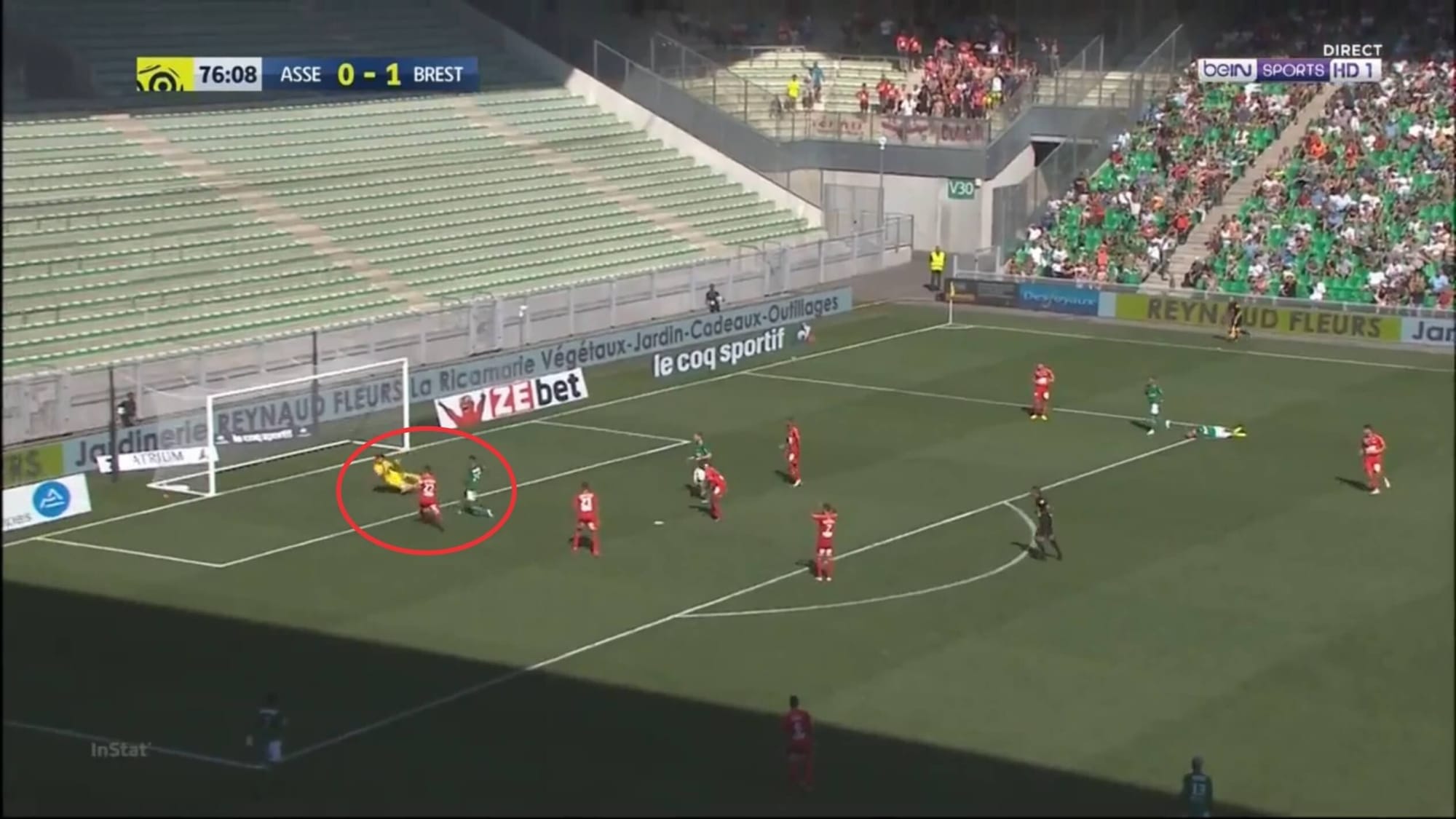
Larsonneur is particularly very strong in saving close-range shots rather than long-range shots. This is mostly due to his quick reflexes, quick reactions, agility, as well as concentration. He’s always on his toes, always focused, and always in the game. He also shows excellent composure and calmness, especially in one-on-one situations. This is why he thrives in those situations. His ability to quickly recover (as mentioned in the previous section) also proved to be quite crucial as sometimes he’ll have to make multiple saves in successions.
When it comes to handling the ball, it can be said that Larsonneur is quite strong, however, can be a bit clumsy sometimes although he very rarely makes terrible mistakes. Often times, he’ll look very solid when saving a shot, sometimes even catching the ball mid-air while stretching himself when diving. But on some occasions, he can be seen a bit shaky and loses the ball after handling it but often will be able to quickly recover the ball. He already shows good technique, but there are, of course, some room for improvements. More game time and experience and more time in the training ground will make him better.
Statistically, Larsonneur is one of the best goalkeepers in saving close-range shots with 70% success rate from a total of 32 close-range shots on target. This is the fourth-highest success rate with Gomis, Alexandre Oukidja, and Anthony Lopes in front of him. However, Larsonneur faces the most close-range shots on target as Gomis, Oukidja, and Lopes only faces an average of 16, 27, and 29 respectively.
Strangely enough, Larsonneur is not as strong when it comes to long balls. Larsonneur is the eighth-highest when it comes to success rate with 93% while facing 28 shots on target.
Ball distribution and contribution in the build-up
Brest are a team who like to play from the back albeit tending to progress forward quickly and be vertical-oriented. Larsonneur is involved in the build-up either as the go-to man to escape pressure, for recovery after a failed attack, or as the ball progressor. This means that he needs to have proper ball-playing and passing skills.
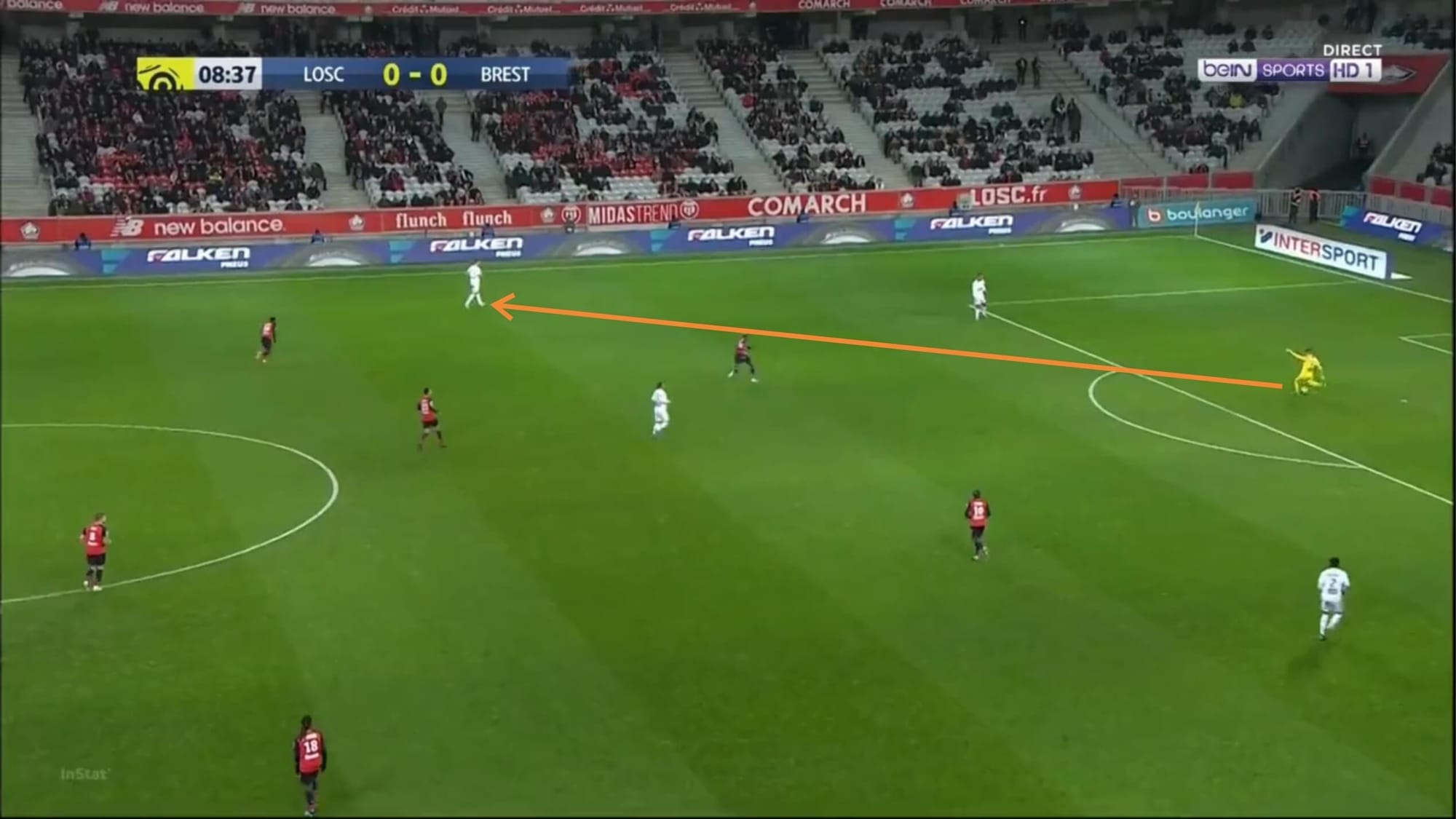
Larsonneur actually shows pretty decent technique when receiving and passing the ball. His first touch may not be very good at times but once he took control, he seems quite neat with the ball. Larsonneur, however, tends to not dwell on the ball and try to attract pressure to himself and will try to move the ball again after receiving it. Larsonneur may not be very awkward with the ball as some more traditional goalkeepers are, but he’s aware that he’s not yet at a high level when it comes to ball-playing ability so he’s still much more cautious when on the ball and avoids risks.
Larsonneur’s passes are actually quite good. He hits the ball with good pace and able to reach great range due to his technique and kicking power. He also shows good vision and confidence to play the ball into certain positions of the pitch just like in the picture above. Larsonneur could have played a safer pass towards a near centre-back but decided to play a pass towards Brest’s loosely-marked right-back. Brest managed to get out of Lille’s high pressure in this situation but lost the ball again in a more advanced position.
Statistically, Larsonneur played an average of 36 passes per game with 84%. That is 3 short passes, 21 medium-range passes, and 12 long passes per game on average. His short and medim passes are 100% and 95% successful respectively. However, his long passes are only 63% successful. That is only the 18th-best when compared to other goalkeepers in Ligue 1 with similar playing minutes this season in Ligue 1. Gerónimo Rulli and Alfred Gomis are the leaders in this department with 83% accuracy.
This shows that despite having good technique and range of passes as well as ability to pick out his teammates, Larsonneur hasn’t yet perfected his long passing ability. His accuracy is a bit off sometimes and the long passes often look like they are not hit with purpose.
However, there’s another factor that perhaps also contribute to his low success rate in long passing. That is their centre-forwards’ inability to win aerial duels. Sometimes, Larsonneur’s long passes are already hit with perfect pace and weight but the centre-forward is unable to win the aerial ball. Gaëtan Charbonnier averages 5.9 aerial challenges this season, however, only wins 36% of them. Alexandre Mendy, meanwhile, registers an average of 3.6 aerial duels with only 45% success rate. Both are actually big, powerful strikers who can be dangerous with their headers when inside the box, but apparently not very proficient in winning aerial balls from goalkeeper’s distributions.
Brest are not only quick in the build-up, but they’re also very quick on the break and Larsonneur plays a huge part in attacking transitions. His ability to quickly and accurately deliver the ball with his hands or feet to start the attack proved to be very vital in Brest’s tactics.
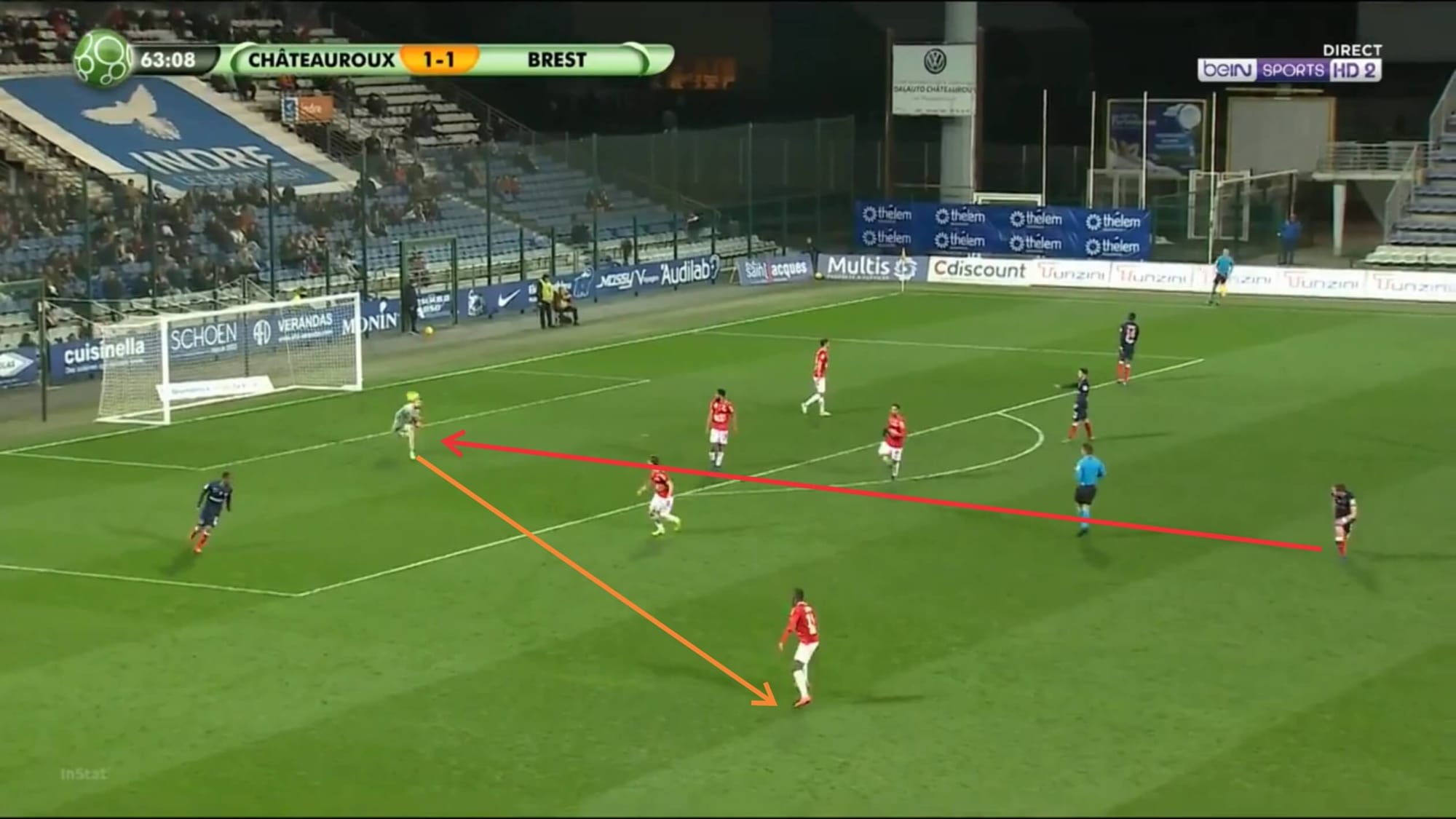
The picture above is an example of Brest’s tendency to break forward quickly in transitions. Larsonneur managed to save a long shot from a Châteauroux attacker and immediately restarted the attack by throwing the ball to a free teammate upfront. He shows quick thinking, good decision making, and once again, good vision as he quickly stood up and spotted a free teammate to throw the ball to.
Larsonneur’s hand passes (throws) are done with pretty much flawless accuracy and he rarely makes mistakes such as throwing the ball towards a teammate who is marked. Statistically, Larsonneur registers an average of four throws per game with 100% accuracy.
Despite the accuracy though, he’s not exactly a very powerful thrower. His hand distributions seem to mostly not reach great range. There are a few times where he’s able to throw very far but this is not consistently happening in a game.
Aside from hand distributions, foot distributions are also often used.
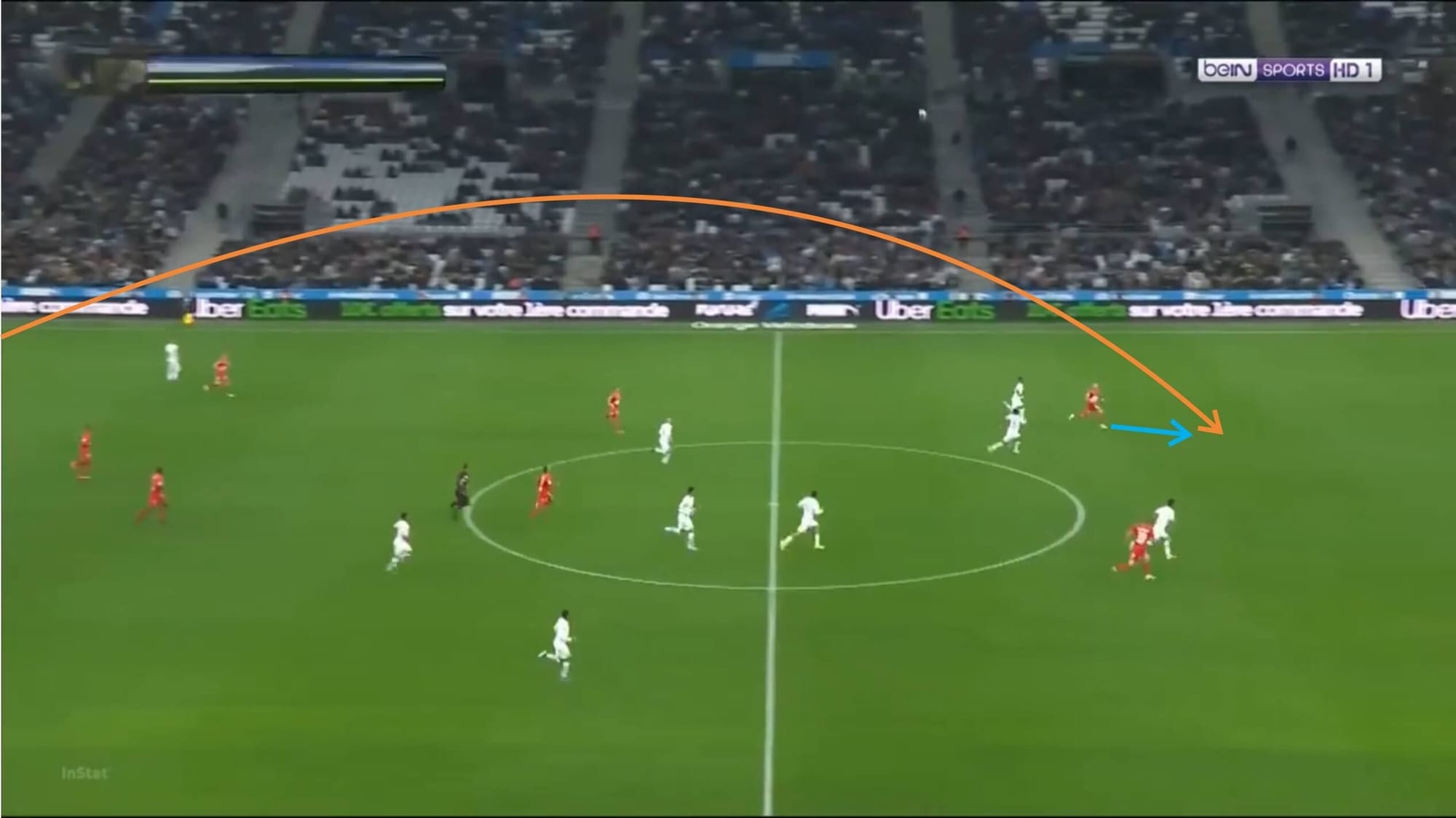
Larsonneur are a bit more proficient with his foot distributions rather than hand distributions. As mentioned, several times in this tactical analysis/scout report, Larsonneur has good eyes. He also has good kicking power and technique, allowing him to deliver long-range passes into the back of the defence. Again, linking back to his long pass accuracy, sometimes this strategy doesn’t work well as his passes can be a bit inaccurate. But when it works, it can be extremely dangerous for the opposing team.
Conclusion
A goalkeeper’s task may sound as simple as just keeping the ball out but nowadays goalkeepers are expected to contribute a lot more to the game, especially in the attacking phase. Upon closer inspection, ‘keeping the ball out’ may also not be as simple as it sounds as there are many, many aspects in goalkeeping that a goalkeeper should pay attention to.
Larsonneur proves that he possesses good tactical understanding and goalkeeping technique that really helps him contribute both in defence and offence. Though there are still some weaknesses in his game, Larsonneur is still quite young and there is still some room for improvements.
The 22-year-old goalkeeper (who’ll turn 23 this year) has proven that he’s good enough to step up from Ligue 2 to Ligue 1 this season. At the moment, Brest look like they’re relying a lot, perhaps too much, on Larsonneur to keep the side from conceding but lately, it seems quite apparent that he’s ready for a more difficult challenge at a better club. Larsonneur’s contract expires in June 2021 and with his contract nearing its end, he could be available for a bargain fee next summer.

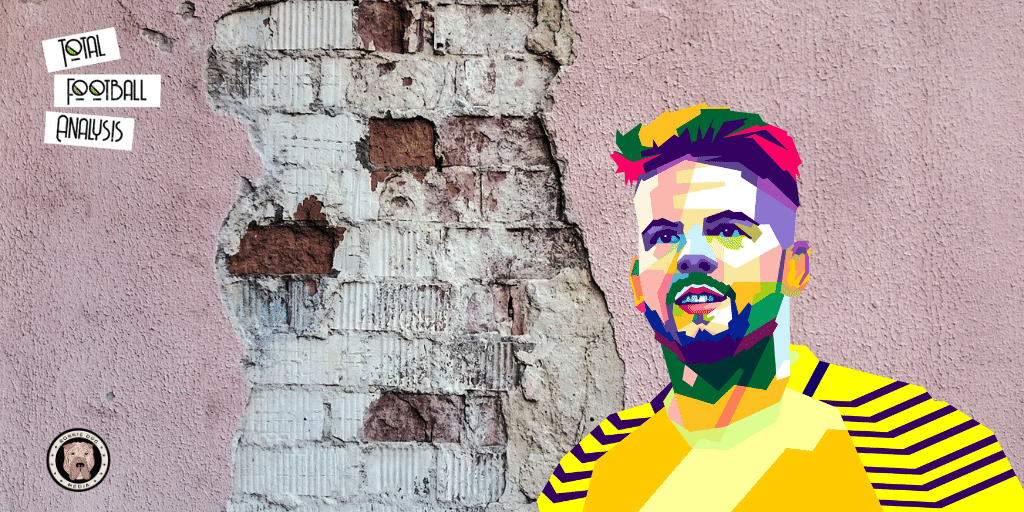
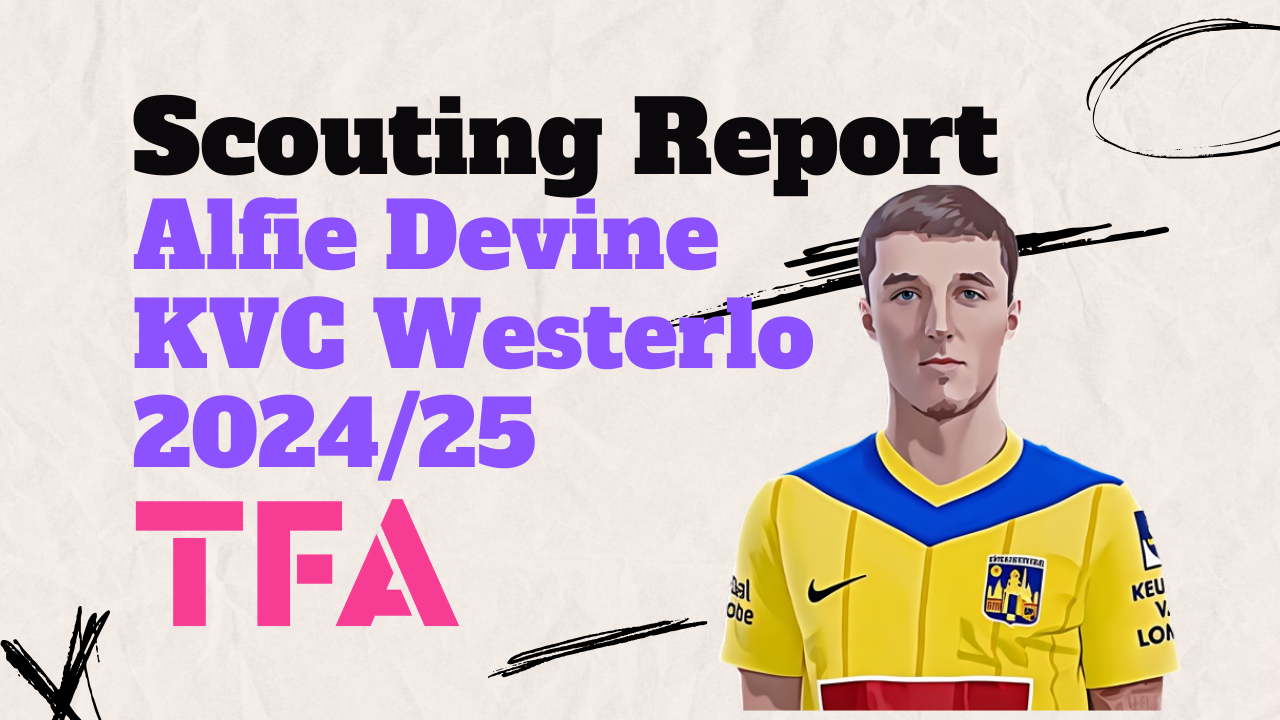
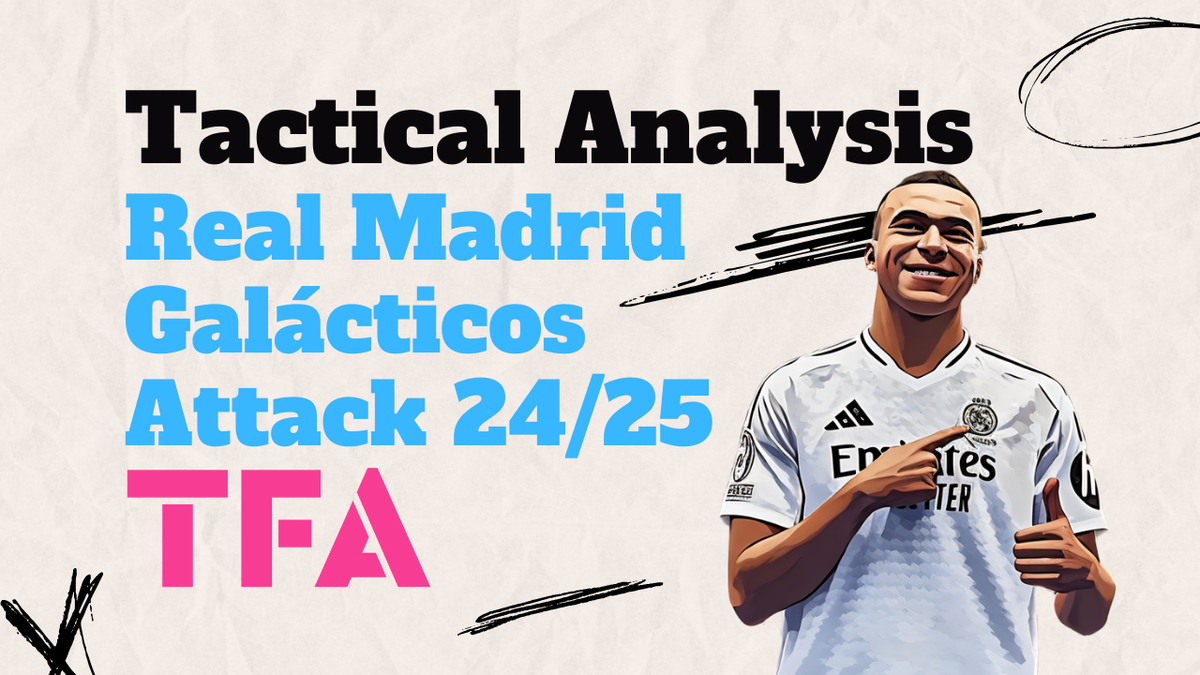
Comments